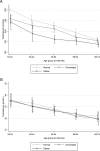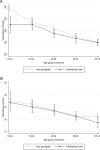Salivary Testosterone Levels and Health Status in Men and Women in the British General Population: Findings from the Third National Survey of Sexual Attitudes and Lifestyles (Natsal-3)
- PMID: 27552539
- PMCID: PMC5095233
- DOI: 10.1210/jc.2016-1669
Salivary Testosterone Levels and Health Status in Men and Women in the British General Population: Findings from the Third National Survey of Sexual Attitudes and Lifestyles (Natsal-3)
Abstract
Context: Salivary T (Sal-T) measurement by liquid chromatography-tandem mass spectroscopy resents the opportunity to examine health correlates of Sal-T in a large-scale population survey.
Objective: This study sought to examine associations between Sal-T and health-related factors in men and women age 18-74 years.
Design and setting: Morning saliva samples were obtained from participants in a cross-sectional probability-sample survey of the general British population (Natsal-3). Self-reported health and lifestyle questions were administered as part of a wider sexual health interview.
Participants: Study participants included 1599 men and 2123 women.
Methods: Sal-T was measured using liquid chromatography-tandem mass spectroscopy. Linear regression was used to examine associations between health factors and mean Sal-T.
Results: In men, mean Sal-T was associated with a range of health factors after age adjustment, and showed a strong independent negative association with body mass index (BMI) in multivariable analysis. Men reporting cardiovascular disease or currently taking medication for depression had lower age-adjusted Sal-T, although there was no association with cardiovascular disease after adjustment for BMI. The decline in Sal-T with increasing age remained after adjustment for health-related factors. In women, Sal-T declined with increasing age; however, there were no age-independent associations with health-related factors or specific heath conditions with the exception of higher Sal-T in smokers.
Conclusions: Sal-T levels were associated, independently of age, with a range of self-reported health markers, particularly BMI, in men but not women. The findings support the view that there is an age-related decline in Sal-T in men and women, which cannot be explained by an increase in ill health. Our results demonstrate the potential of Sal-T as a convenient measure of tissue androgen exposure for population research.
Figures
References
-
- Bhasin S, Cunningham GR, Hayes FJ, et al. Testosterone therapy in men with androgen deficiency syndromes: An Endocrine Society Clinical Practice Guideline. J Clin Endocrinol Metab. 2010;95(6):2536–2559. - PubMed
-
- Yeap BB, Araujo AB, Wittert GA. Do low testosterone levels contribute to ill-health during male ageing? Crit Rev Clin Lab Sci. 2012;49(5–6):168–182. - PubMed
-
- Haring R, Baumeister SE, Völzke H, et al. Prospective inverse associations of sex hormone concentrations in men with biomarkers of inflammation and oxidative stress. J Androl. 2012;33(5):944–950. - PubMed
-
- Wu FC, Tajar A, Pye SR, et al. Hypothalamic-pituitary-testicular axis disruptions in older men are differentially linked to age and modifiable risk factors: The European Male Aging Study. J Clin Endocrinol Metab. 2008;93(7):2737–2745. - PubMed
MeSH terms
Substances
Grants and funding
LinkOut - more resources
Full Text Sources
Other Literature Sources
Medical



